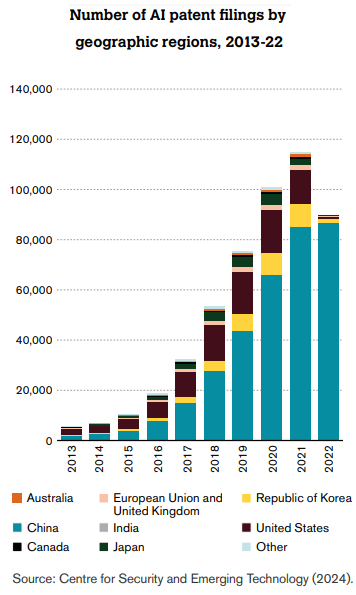China dominates in terms of the number of Artificial Intelligence patents registered in the world, according to statistics from the World Trade Organization (WTO).
The global artificial intelligence market has shown significant growth. In 2022, it was valued at $428 billion. Moreover, it is projected to reach $2.25 trillion by 2030.
This growth translates into a Compound Annual Growth Rate (CAGR) between 33.2% and 38.1%. On the other hand, the impact of AI is evident globally. According to fortunebusinessinsights.com, the sector is expected to employ up to 97 million people by 2025.
A WTO report showed that China is by far the leading economy in terms of the number of AI patents filed, with 86,663 AI patent applications and 15,869 patents granted in 2022, followed by the Republic of Korea and the United States.

For the WTO, this disparity reflects the underlying technological differences between economies and underscores the importance of facilitating technology diffusion and technical assistance to close the gap globally.
Number of Artificial Intelligence patents
Some companies that stand out in this industry are Alphabet, Microsoft, Amazon, Baidu, IBM, NVIDIA, H2O.ai, Oracle, Hewlett Packard and Salesforce.
Key concerns highlighted by the WTO include the uneven distribution of AI research, patents, and investment. These resources are heavily concentrated in certain regions, leaving others significantly behind.
This divide is evident both between and within economies. Additionally, it reflects disparities between urban areas and rural regions that are less connected digitally. And the growing risk is that this gap could widen further, exacerbating existing inequalities.
The number of articles published on AI has steadily increased, with industry leading the way. The number of articles published on AI has increased steadily, except in the United States, where there was a drop in 2022.
In addition to differences in the ability to adopt AI technologies, the AI gap between economies, reflected in AI research and development (R&D), investment and expertise, highlights the need to address gaps in AI capabilities.

